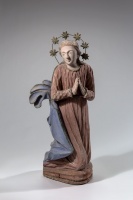

St Joseph (from a Holy Family scene)
| Author: |
Antanas Klanius-Klanevičius (1830–1920) |
| Created: | late 19th–early 20th century |
| Material: | wood |
| Technique: | carving, colour paint |
| Dimensions: | 100 × 32 cm |
Kretinga district
Unlike other religious carvers, Antanas Klanius-Klanevičius (1830–1920), who lived in the village of Mažonai in the Kretinga district, was a wealthy farmer; but he disliked farming, and spent more time on woodcarving and metalwork. Not only did he carve sculptures, but he also made shrines, crosses, altars and woodcuts, and painted in oils on canvas. His clients were the clergy, wealthy farmers and landowners. Klanius-Klanevičius had apprentices, who expressed their great respect for his work (there are some works by one of them, Juozapas Paulauskas, in the collection too). This sculpture probably represents St Joseph, from a sculptural group of the Holy Family, which consisted of the figures of the Blessed Virgin Mary and St Joseph leading Jesus by the hand.
In the Christian tradition, St Joseph, a carpenter from Nazareth, the husband of the Virgin Mary, and the foster-father of Jesus, is the guardian of the family, protecting it and helping it to survive in times of hardship. He also prepared Jesus for his ministry, and is therefore considered the perfect father. St Joseph was revered in the Lithuanian countryside as the patron saint of families, and also as the patron of a happy death. This derives from the story that he died in the arms of Jesus and Mary at the age of 111, and his death is therefore considered the happiest death a man can have.
Text author Skaidrė Urbonienė
Source: Law firm Valiunas Ellex art album HEAVEN AND BEYOND (2016). Compiler Dalia Vasiliūnienė. Text authors Dalia Vasiliūnienė, Skaidrė UrbonienėExpositions: “Heaven and Beyond. Works of religious art from the collection of Rolandas Valiūnas and the law firm Valiunas Ellex“, 31 May–24 September 2016, Church Heritage Museum, Vilnius (curators Dalia Vasiliūnienė, Skaidrė Urbonienė)








